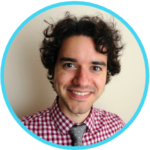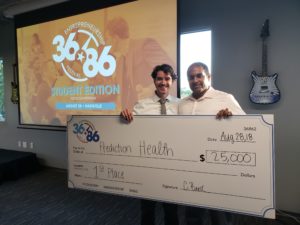Catching Up with Pedro Texeira and Ravi Atreya
A conversation transcribed by Abin Abraham (G2)

 Ravi Atreya and Pedro Teixeira are current MSTP students on a leave from coursework to pursue their dream of launching a startup focused on addressing major problems in health care delivery. We caught up with them to learn more about their journey. Ravi and Pedro successfully defended their Ph.D.s in 2016 and 2015 respectively in the Department of Biomedical Informatics. Ravi’s thesis project focused on visualizing treatment path patterns in breast cancer working with Dr. Mia Levy. Pedro’s thesis project used the electronic health record (EHR) to uncover genotype-phenotype relationships working in Dr. Josh Denny’s lab. Ravi and Pedro launched PredictionHealth in 2017, a start up company focused on solving a major challenge in healthcare: improving how we use, deposit, and retrieve information in the EHR. Below is a short interview describing their thoughts and unique pathway during their MSTP training.
Ravi Atreya and Pedro Teixeira are current MSTP students on a leave from coursework to pursue their dream of launching a startup focused on addressing major problems in health care delivery. We caught up with them to learn more about their journey. Ravi and Pedro successfully defended their Ph.D.s in 2016 and 2015 respectively in the Department of Biomedical Informatics. Ravi’s thesis project focused on visualizing treatment path patterns in breast cancer working with Dr. Mia Levy. Pedro’s thesis project used the electronic health record (EHR) to uncover genotype-phenotype relationships working in Dr. Josh Denny’s lab. Ravi and Pedro launched PredictionHealth in 2017, a start up company focused on solving a major challenge in healthcare: improving how we use, deposit, and retrieve information in the EHR. Below is a short interview describing their thoughts and unique pathway during their MSTP training.
How and when did your start-up journey begin?
We met during second look weekend as roommates in 2009 and after our first year of medical school, it was obvious that there were two major issues with how we use electronic health records: it takes a significant amount of time to write notes and leverage this data for research and quality improvement projects. One of the first things we did to tackle this issue was participating in the ‘Reinventing Clinical Documentation’ student challenge through JAMIA in 2013. Here we worked with Dr. Michael Poku (entering class of 2013 with us, MD/MBA) and won 2nd place. The competition offered a space for brainstorming and imagining several solutions to improve how we use the EHR. Throughout our graduate phase, we got an even closer look at some unique challenges of EHR data. I [Pedro] was using data from StarPanel to find new genotype-phenotype relationships and quickly realized that the free-text notes entered were limiting research opportunities due to their variability and frequent mistakes and omissions. As we finished our Ph.D. work we decided to commit to pursuing this challenge full time by launching our startup. This was a strategic time to get involved since hospital systems across the nation had transitioned to electronic health records and significant progress was starting to be made on interoperability between the many EHR systems.
What type of support or advice was available to you when transitioning to work on the start-up?
Deciding to delay our training was difficult. However, the Vanderbilt Medical School and MSTP Leadership Team were supportive. They helped us customize our curriculum to fulfill our academic requirements while also pursuing our dream. To learn more about how to run a startup, we used the (free) online resource startupschool.org/library. For anybody interested in the start-up pathway, we highly recommend this resource. We were also accepted into the Y Combinator startup school online course. Y Combinator is a well known accelerator that provides many great resources for early stage companies. As part of their startup school program, we met with an alumni mentor every week. We were encouraged to create a prototype and deploy it in a real world setting as quickly as possible instead of trying to create a perfect or near-perfect product. Learning how to prioritize and execute quickly is one of the best lessons we’ve learned.
Can you tell us a bit more what you are working on?
In the beginning, we spent much of our time coding and prototyping. The goal was to build a predictive interface on a tablet that a physician could use while seeing patients. Deploying the prototypes in clinics, it became obvious to us that a physician could never use the tablet by itself. They also needed access to information on their computers and laptops. Bringing the many interfaces together was a very hard problem, so we had to simplify. Testing our prototype as early as possible provided the insight that we had to work on a problem that caused the greatest friction for the clinician working with the EHR. Therefore, we reoriented and created a web based interface that transcribes clinic notes during the patient visit. This allows the physician to focus on the patient. Within two weeks we began testing a new prototype that generated a lot of excitement from the clinicians. Currently, the product has a very simple interface with a single button to start and stop the recording and the the transcription is displayed in real time on screen. Within a day of the visit, the whole note is finalized, reviewed by a remote human to ensure high-quality documentation, and returned to the physician within their EHR.
Where do you see yourselves and company in the next 5 years?
This is a mission oriented company. Although it’s great to solve the inconvenience of medical documentation, the mission is to improve the delivery of healthcare. Doctors and artificial intelligence working together can help make sure that every patient gets the best care, every time. In the next five years, we want to focus on having the EHR data structured in real time so it’s easy to apply machine learning while doctors are talking with their patients – surfacing useful information when it’s needed and providing relevant suggestions in a way that is interactive but also minimally disruptive.
 Ravi and Pedro recently took first place in the 36|86: Student Edition pitch competition. Read more here.
Ravi and Pedro recently took first place in the 36|86: Student Edition pitch competition. Read more here.
